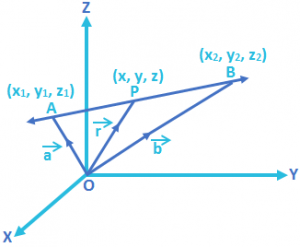Equation of Line passing through Two given Points
Vector Form:

From the figure, \(\overrightarrow{OP}\,=\,\overrightarrow{r},\,\overrightarrow{OA}\,=\,\overrightarrow{a}\) and \(\overrightarrow{OB}\,=\,\overrightarrow{b}\).
Since \(\overrightarrow{AP}\) is collinear with \(\overrightarrow{AB}\), \(\overrightarrow{AP}\,=\,\lambda \,\overrightarrow{AB}\) for some scalar λ, we have
\(\overrightarrow{OP}\,-\,\overrightarrow{OA}\,=\,\lambda \,\left( \overrightarrow{OB}\,-\,\overrightarrow{OA} \right)\).
or \(\overrightarrow{r}\,-\,\overrightarrow{a}\,=\,\lambda \,\left( \overrightarrow{b}\,-\,\overrightarrow{a} \right)\).
or \(\overrightarrow{r}\,=\,\overrightarrow{a}\,+\,\lambda \,\left( \overrightarrow{b}\,-\,\overrightarrow{a} \right)\) … (i)
Therefore, the equation of a straight line passing through \(\overrightarrow{a}\) and \(\overrightarrow{b}\) is \(\overrightarrow{r}\,=\,\overrightarrow{a}\,+\,\lambda \,\left( \overrightarrow{b}\,-\,\overrightarrow{a} \right)\).
Cartesian Form:
We have \(\overrightarrow{r}\,=\,x\hat{i}\,+\,y\hat{j}\,+\,z\hat{k},\,\overrightarrow{a}\,=\,{{x}_{1}}\hat{i}\,+\,{{y}_{1}}\hat{j}\,+\,{{z}_{1}}\hat{k}\) and \(\,\overrightarrow{r}\,=\,{{x}_{2}}\hat{i}\,+\,{{y}_{2}}\hat{j}\,+\,{{z}_{2}}\hat{k}\).
Substituting these values in (i), we get
\(x\hat{i}\,+\,y\hat{j}\,+\,z\hat{k}\,=\,{{x}_{1}}\hat{i}\,+\,{{y}_{1}}\hat{j}\,+\,{{z}_{1}}\hat{k}\,+\,\lambda \left[ \left( {{x}_{2}}\,-\,{{x}_{1}} \right)\hat{i}\,+\,\left( {{y}_{2}}\,-\,{{y}_{1}} \right)\hat{j}\,+\,\left( {{z}_{2}}\,-\,{{z}_{1}} \right)\hat{k} \right]\).
Equating the coefficients of \(\hat{i}\), \(\hat{j}\) and \(\hat{k}\), we get
\(x\,=\,{{x}_{1}}\,+\,\lambda \,\left( {{x}_{2}}\,-\,{{x}_{1}} \right)\); \(y\,=\,{{y}_{1}}\,+\,\lambda \,\left( {{y}_{2}}\,-\,{{y}_{1}} \right)\); \(z\,=\,{{z}_{1}}\,+\,\lambda \,\left( {{z}_{2}}\,-\,{{z}_{1}} \right)\).
On eliminating λ, we obtain \(\frac{x\,-\,{{x}_{1}}}{{{x}_{2}}\,-\,{{x}_{1}}}\,=\,\frac{y\,-\,{{y}_{1}}}{{{y}_{2}}\,-\,{{y}_{1}}}\,=\,\frac{z\,-\,{{z}_{1}}}{{{z}_{2}}\,-\,{{z}_{1}}}\,=\,\lambda \).
which is the equation of the line in Cartesian form.
Example: The Cartesian equation of a line is \(\frac{x-3}{2}=\frac{y+1}{-2}=\frac{z-3}{5}\). Find the vector equation of the line
Solution: Given that \(\frac{x-3}{2}=\frac{y+1}{-2}=\frac{z-3}{5}\).
Note that it passes through (3, -1, 3) and
Is parallel to the line whose direction ratios are 2, -2, and 5.
Therefore, its vector equation is \(\overrightarrow{r}=3\hat{i}-\hat{j}+3\hat{k}+\lambda \left( 2\hat{i}-2\hat{j}+5\hat{k} \right)\).
Where λ is a parameter
